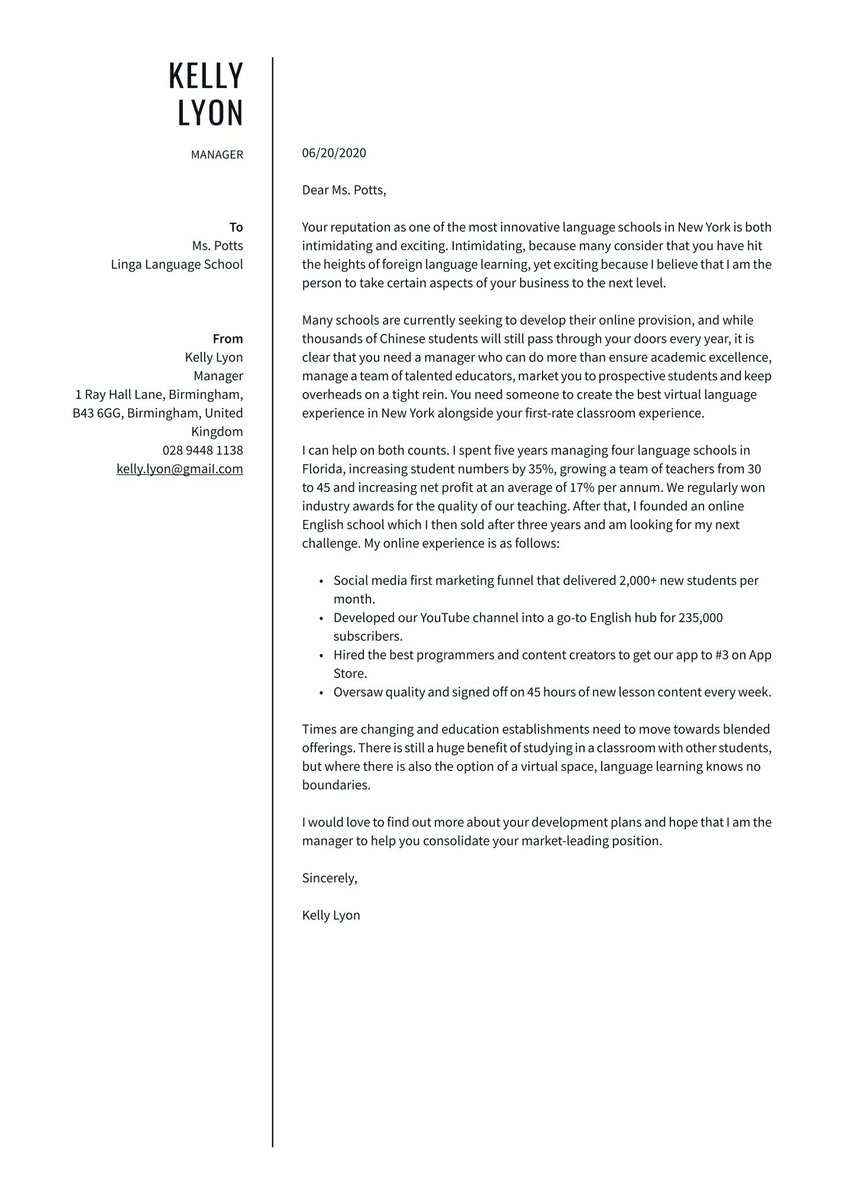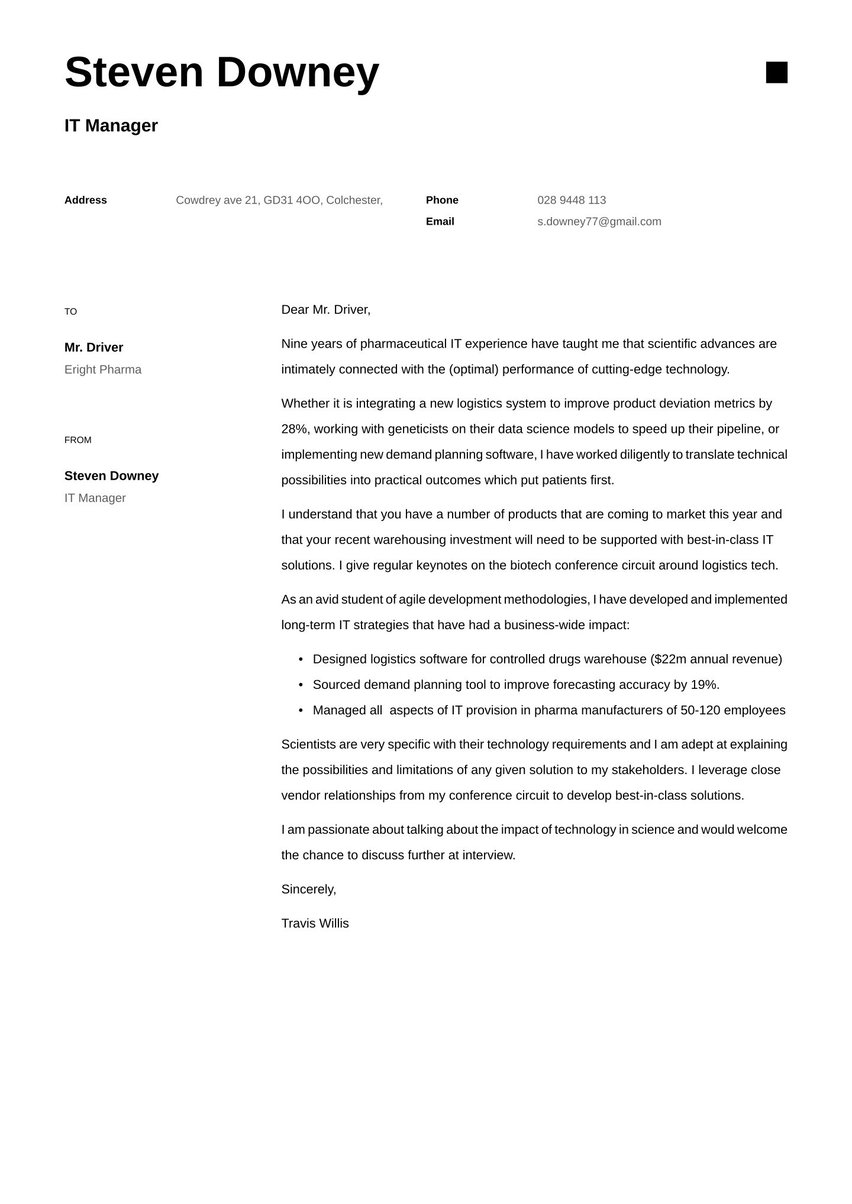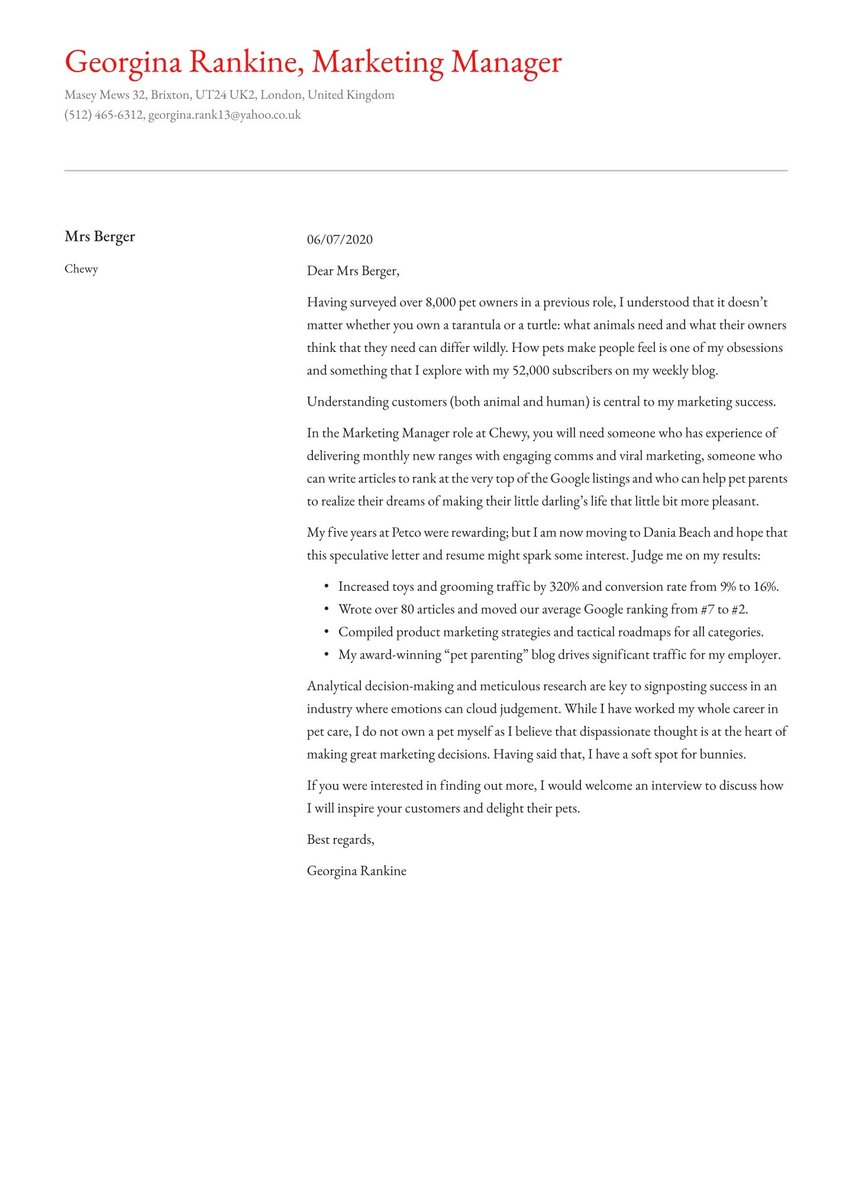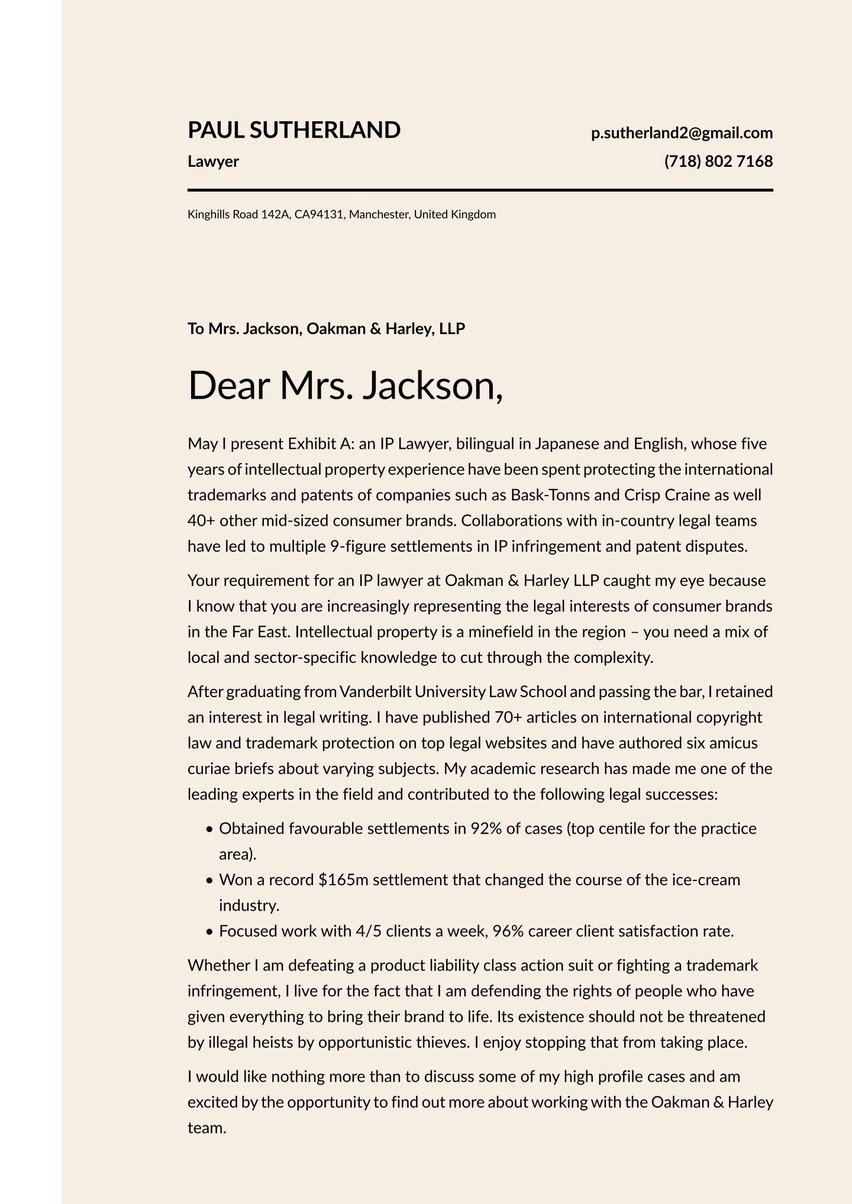Engineers are in short supply in the UK, but your engineering cover letter should still be given careful consideration. There are many different types of engineers, including civil engineers, mechanical, and electrical. Within these, there are further subspecialty options. For instance, a civil engineer can choose to work on rails, roads, bridges, and much more.
Most employers expect engineering candidates to have a clear vision of where they want to work and why. It's important to take care with your cover letter when applying for engineering jobs.
This writing guide will provide useful information about the best way to structure your engineering cover letter to stand out from the other job applicants. Step-by-step, we'll take you through the process of creating a cover letter that measures up to your unique expertise.
Engineering full text-only cover letter example
Dear Mr. Kristianson,
Having contributed to the design and manufacture of more than 35 devices, used by millions of patients over the past decade, I was recently recognised by Engineering News as one of the top five mechanical engineers in the medical devices field.
My experience in bringing together clinically cutting-edge system architectures, materials, and components stems from a deep passion for research and development. My own design and verification process formed the blueprint for my consultancy work. Now I believe I may be in a position to tweak certain aspects of Engineero’s already stellar operation.
As a proficient user of Boldworks, I invite you to look at a portfolio of solutions incorporated in my previous designs. There are a number of patents to my name, with one particular solution for ingress protection in a Class III medical device winning an “innovation of the year” award from NaaTech.
I take pride in the quality of my design review process, with top-quality 3D renderings, models and animations bringing the reality and practicality of the design to life. An intragastric balloon inflation system became the market leader within 18 months. I also have a deep knowledge of drug delivery systems and insulin pump solutions — particularly the specialisations for which Engineero is rightfully well-known.
My consultancy work during the past three years has yielded 12 product designs driving over $15m in sales. I now look forward to joining a company that prides itself on broader employee development. When you work alongside talented colleagues, your designs take on a new dimension.
I am excited at the prospect of an interview to find out what projects you have in the pipeline and how I might play a part in your future success.
Yours sincerely,
Leslie Philoberto
Sections of an engineering cover letter
Much like a software development project, a good cover letter for an engineering job goes through different stages until it becomes a shiny final product. Here are the key sections to consider:
- Cover letter header. Choose a distinctive header that details vital information, including your name, contact details, and main job title.
- Greeting. Personalise your cover letter greeting by finding out the hiring manager's name so you can address them directly.
- Introduction. Capture the reader's attention with an intriguing opening to your engineering cover letter, that hints at why you will be a perfect addition to the team..
- Body. Showcase your experience and achievements as an engineer, focusing on how your skills and strengths can help the company achieve similar success.
- Conclusion. Conclude by reiterating your interest in the role and your qualifications. Include an engaging call to action, inviting the hiring manager to reach out.
- Signature. End with a professional closing, including your name.
Cover letters generally allow you a degree of freedom to write as you see fit, but they also must be relatively short, so it's important to get your message across concisely. Think of your engineering cover letter as the first stage of the engineering design process — identifying the need. What does the hiring manager want, and how can you convey your ability to meet these needs through your cover letter?
Stick to a short and snappy one-page cover letter. Hiring managers receive hundreds of applications after posting a job, so make their lives easier by getting straight to the point.
Looking for some inspiration? View our library of unique cover letters, including the following cover letter examples relatable to engineering:
If you need more general information and details covering each section, read our article on how to write a cover letter.
Introduction of an engineering cover letter
Your first chance to hook the reader is via your introduction. When starting your cover letter, generate some interest by mentioning a notable achievement, anecdote, or backstory.
This section of your cover letter is also a golden opportunity to show how you align with the prospective employer’s goals and objectives.
Dear Mr. Kristianson,
Having contributed to the design and manufacture of more than 35 devices, used by millions of patients over the past decade, I was recently recognised by Engineering News as one of the top five mechanical engineers in the medical devices field.
Dear Sir or Madam
I am writing to inform you of my interest in the engineering role with Envio Company. I consider myself to have the ideal blend of skills and experience to excel in the role and would prove an asset to the team.
The trick here is to adopt a professional and confident tone. Avoid a generic introduction that the hiring manager has probably read a thousand times. Mentioning your back story can strike a chord with the hiring manager and motivate them to learn more about you.
Engineering cover letter body
In the body of your cover letter, follow a clear template:
- Showcase your engineering skills and expertise.
- Prove that you'll be an excellent fit for the team culture, whether you're applying to a small, specialized tech firm or a large multinational corporation.
- Conclude with a strong and memorable ending.
- Wrap up with a compelling call to action encouraging the hiring manager to reach out.
First body paragraph
Pack some punch with a first body paragraph that highlights your technical expertise and achievements. Here’s how you can present this information in the best possible light:
- Highlight key achievements. Quantifying elements of your employment experience strengthens the impact of your cover letter — for instance, the number and size of teams you have worked with and the value of projects.
- Emphasise your expertise. Dive into your specific engineering expertise, such as modern construction practices, sustainability, and tools such as AutoCAD or Revit.
- Collaboration. Highlight your collaborative approach, including success working closely with cross-functional teams and engaging with key stakeholders.
- Showcase your industry knowledge. Demonstrating an understanding of company operations, future opportunities, and any competitors will help you stand out.
- Motivational leadership. If applicable, reference specific examples of how you have motivated and provided guidance to project teams or new hires.
Share a specific project you worked on and what you enjoyed about it
It can be difficult sometimes to get a real feel for job candidates just going by what they say. That’s the difficulty hiring managers often have. However, if you support your claims with examples, this offers a much clearer idea of your capabilities. This doesn’t mean you need to list off everything you’ve worked on, but just the most memorable projects, especially those with a high value.
Second body paragraph
Always be aware of your audience when composing a cover letter. For example, if you are applying for an engineering role in a small company, it would not be appropriate to mention that you are excited at the prospect of potential career progression. This is unlikely to be possible soon, and therefore, it will instantly make them apprehensive about hiring you.
In this example from the Environment Agency, some key points that can be taken from their mission and values include:
- Mission to create a better place for people and wildlife, and support sustainable development
- Priority to work with businesses and other organisations to manage the use of resources
- Increase the resilience of people, property and businesses to the risks of flooding and coastal erosion
- Protect and improve water, land and biodiversity
Including details from the company’s mission and values will help you to connect with the employer. Mentioning a specific example of where you worked on a cutting-edge sustainability project could strike a chord with recruiters.
My experience in bringing together clinically cutting-edge system architectures, materials, and components stems from a deep passion for research and development. My own design and verification process formed the blueprint for my consultancy work. Now I believe I may be in a position to tweak certain aspects of Engineero’s already stellar operation.
As a proficient user of Boldworks, I invite you to look at a portfolio of solutions incorporated in my previous designs. There are a number of patents to my name, with one particular solution for ingress protection in a Class III medical device winning an “innovation of the year” award from NaaTech.
I take pride in the quality of my design review process, with top-quality 3D renderings, models and animations bringing the reality and practicality of the design to life. An intragastric balloon inflation system became the market leader within 18 months. I also have a deep knowledge of drug delivery systems and insulin pump solutions — particularly the specialisations for which Engineero is rightfully well-known.
My consultancy work during the past three years has yielded 12 product designs driving over $15m in sales. I now look forward to joining a company that prides itself on broader employee development. When you work alongside talented colleagues, your designs take on a new dimension.
Call to action & conclusion
Your cover letter conclusion should sound confident and self-assured without coming across as arrogant. The best way to finish off your engineering cover letter is to reaffirm why you feel you are right for the job.
If there’s anything particularly exceptional about you or your experience, you may want to mention it here. If the hiring manager has read your cover letter and is still unsure, the conclusion could alleviate any concerns about taking your application further. Leave recruiters with something they won’t be able to resist.
I am excited at the prospect of an interview to find out what projects you have in the pipeline and how I might play a part in your future success.
Yours sincerely,
Leslie Philoberto
Finally, sign off with a professional closing, such as ‘Sincerely.’ Remember to proofread your letter and ensure that it is error-free.
Key takeaways
If you’re looking for your dream engineering job, you’ll need to highlight your technical expertise, stellar project management capabilities, and collaborative approach.
A cover letter is the perfect place to tell the backstory of how you became an engineer and your workplace achievements. Provide examples of relevant projects you have worked on, specifically those of high value. You can use university examples if you have no work experience.
Try our cover letter builder to create a compelling engineering cover letter and boost your job interview prospects!



























